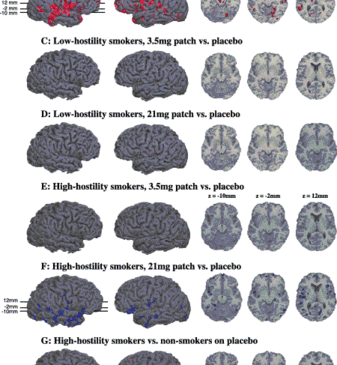Many smokers claim that smoking relieves anxiety and helps promote relaxation. Such claims are consistent with a self-medication motive for lighting up (Khantzian, 1997). Khantzian’s self-medication theory suggests, in part, that individuals engage in behaviors, sometimes excessively and harmfully, to compensate for problems like depression or anxiety. This week ASHES reviews a study of hostility, a problem that is often associated with an increased susceptibility to nicotine dependence. If Khantzian’s self-medication theory applies, nicotine is a way for people with hostile tendencies to diminish these feelings. In a recent study by Fallon, Keator, Mbogori, Turner, and Potkin (2004), the authors examined whether an individual’s tendencies toward hostility relate to their neurological reactions to nicotine.
The researchers recruited 86 participants: 55 non-smokers (i.e., smoked less than 10 cigarettes in their life and none in the past two years) and 31 smokers (i.e., more that 10 cigarettes per day for the past two years). Results from clinical interviews using the Cook-Medley items from the MMPI (Hathaway and McKinley, 1942, 1943; Butcher et al., 1989) determined whether participants were high-hostility (i.e. a score of at least 25 on the Cook-Medley items for men and 18 for women) or low-hostility: 24 non-smokers and 19 smokers were high-hostility. Participants then performed a hostility task (i.e., the Bushman Competitive Reaction Task (BCRT1) (Bushman, 1995). For this task participants compete with a supposed “opponent” to complete a particular task first. At the conclusion of each task the winner blasts the slower “opponent” with noise; in this study aggression is measured both by the length of the noise blast and its intensity, which is set by the winner. Non-smokers performed the hostility task under each of two, randomly ordered, experimental conditions, a placebo patch or a 3.5mg nicotine patch. Smokers had an added condition of a 21mg nicotine patch. The researchers (2004) monitored neurological activity during the task using Positron Emission Tomography (PET).
High- and low-hostility non-smokers did not differ on the BCRT under any experimental condition; smokers showed mixed results. In the placebo condition, high-hostility smokers blasted mock opponents for longer time periods than did low hostility smokers (251 ms vs. 180 ms); however, in the 21 mg nicotine condition, low-hostility smokers applied shock at a higher decibel level (7.1 dB vs. 5.4 dB) than high-hostility smokers.
Neither low-hostility smokers nor low-hostility non-smokers showed a change in brain metabolic activity between the placebo and nicotine conditions (see Figure, Rows A, C, and D). Among high-hostility people, smokers showed greater metabolic activity on placebo than high-hostility non-smokers (Row G), which suggests that nicotine might be used as a form of self-medication. There was virtually no difference in metabolic activity between smokers and nonsmokers on the low-nicotine dose (Row H). The lack of difference results from nicotine increasing activity among high-hostility non-smokers (Row B) but not among high-hostility smokers (Row E). Because the low nicotine dose did not change the metabolic activity for smokers, this does not necessarily support the idea that nicotine is used as a way of self-medicating. The low-dose nicotine did not change metabolic activity among low-hostility smokers (Row C) or high-hostility smokers (Row E), but the high dose did dampen activity for high-hostility smokers (F).

Figure. Metabolic differences induced by nicotine patch (2). Click image to enlarge.
Red indicates significantly increased metabolic rate following nicotine compared to placebo.
Blue indicates significantly decreased metabolic rate following nicotine compared to placebo.
Thus, the authors suggest, smoking history modifies the brain’s reaction to nicotine in high-hostility participants, though further research is necessary to determine whether this is the case. These results could be interpreted to suggest that self-medication of hostile tendencies might not be a valid explanation for smoking initiation because, in this experiment, nicotine caused hostile non-smokers to become more aggressive, though it might aid high-hostility smokers in controlling hostile tendencies. This research does show that certain traits may contribute to a person’s susceptibility to addictive behaviors, such as smoking. However, the harm caused by most means of nicotine ingestion is serious and sometimes irreversible. Thus, even if hostile tendencies are minimized in response to nicotine, there may be more healthy and direct ways of coping with hostility.
–Siri Odegaard.
Notes
1. Subjects watched a violent videotape and then competed against a mock opponent in a reaction-time task. The slower participant received a blast of noise from the opponent. Researchers measured the level of aggression as the decibel level and frequency of shocks administered by subjects to mock opponents.
2. Image reprinted from Cognitive Brain Research, Vol. 18, Fallon, J. H., Keator, D. B., Mbogori, J., Turner, J., and Potkin, S., Hostility differentiates the brain metabolic effects of nicotine, p. 142-148, 2004, with permission from Elsevier
References
Bushman, B. J., 1995: Moderating role of trait aggressiveness in the effects of violent media on aggression. Journal of Personality and Social Psychology, 69: 950-960
Butcher, J. N., Dahlstrom, W. G., Graham, J. R., Tellegen, A., and Kaemmer, B., 1989: Minnesota Minnesota Multiphasic Personality Inventory-2 (MMPI-2): Manual for Administration and Scoring. Minneapolis: University of Minnesota Press.
Fallon, J. H., Keator, D. B., Mbogori, J., Turner, J., and Potkin, S., 2004: Hostility differentiates the brain metabolic effects of nicotine. Cognitive Brain Research, 18: 142-148.
Hathaway, S. R. and McKinley, J. C., 1942: The Minnesota Multiphasic Personality Schedule. Minneapolis, MN.
Hathaway, S. R. and McKinley, J. C., 1943: The Minnesota Multiphasic Personality Inventory (Rev. ed., 2nd printing.). Minneapolis, MN.
Khantzian, E. J., 1997: The self-medication hypothesis of substance use disorders: A reconsideration and recent applications. Harvard Review of Psychiatry, 4: 231-244.
What do you think? Please use the comment link below to provide feedback on this article.




